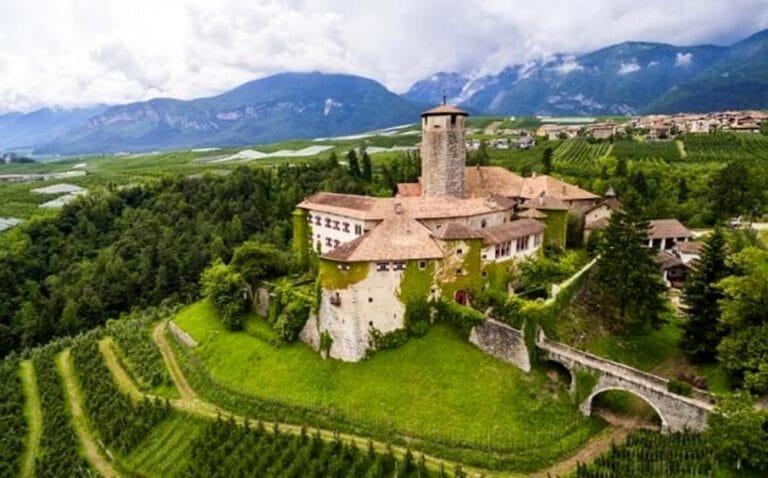Castel Cles: A Historic Castle in Northern Italy
Visitor Information
Google Rating: 3.8
Popularity: Low
Google Maps: View on Google Maps
Official Website: www.cultura.trentino.it
Country: Italy
Civilization: Unclassified
Remains: Military
History
Castel Cles is situated near the town of Cles in northern Italy and occupies a prominent hilltop location in the Non Valley. Archaeological findings reveal that this site has seen continuous human presence since Roman times, with early fortifications or watchtowers likely established before the medieval era, reflecting its enduring strategic importance.
The first clear record of the castle dates to 1124, identifying it as the hereditary residence of the von Cles noble family. The earliest construction was a stone tower erected by Vitale von Cles, serving both as a defensive stronghold and a home. By the mid-13th century, documents describe a well-developed fortress complete with surrounding walls and a central tower known as a bergfried. Ownership had shifted by then to Egno von Eppan, the Bishop of Trento.
In the 15th century, the castle saw several changes in proprietorship. Initially, parts of it were granted as feudal holdings by Georg von Lichtenstein, the Bishop of Trento. Later in 1447, Georg von Cles consolidated ownership, becoming the sole lord of the fortress. A significant historical figure associated with the castle was Bernhard von Cles, born at Castel Cles in 1485. As a Renaissance cardinal and Prince-Bishop of Trento and Brixen, he undertook extensive renovations that transformed the fortress into both a lavish residence and a formidable defensive structure.
The castle suffered heavy damage amid the 1525 peasant uprising but was promptly rebuilt and remodeled in Renaissance style. Bernhard von Cles, along with his nephew Hildebrand, completed this work by 1535, as commemorated by an inscribed stone plaque at the site. Further expansion occurred late in the 16th century under Aliprando von Cles.
In 1609, Hildebrand Reimbert von Cles was declared legally incapacitated by Habsburg authorities and confined within the castle, a measure intended to protect the family’s assets from ruin. The estate’s management passed to Ferdinand von Küepach, whose governance sparked documented complaints the following year.
During the 17th century, Castel Cles gradually lost its military significance. Although its structures fell partially into neglect, it remained in use as an administrative center. A destructive fire in 1825 destroyed the castle’s southern wing and much of its archival records, but restoration efforts followed.
The castle endured the nearby turmoil of both World Wars without serious harm. However, mid-20th-century landscape changes caused by the Santa Giustina dam reshaped the valley and altered the castle’s commanding view of its surroundings. Today, the property remains under the ownership of the Barons von Cles and serves as a private residence, with public entry rarely permitted.
Remains
Castel Cles presents a roughly triangular layout fortified by two successive ring walls that enclose the site. Its main entrance lies on the northern side, historically accessed by a drawbridge spanning a defensive moat. Over time, additional fortifications were added in front of this gate, including bastions and a forecourt known as a vorburg, reinforcing the castle’s defenses.
Originally, the complex included three towers. Two large square towers stand guard on the eastern side, flanking the principal residential building, which is a five-story stone palace featuring numerous rooms under tiled roofs. This main building surrounds a small inner courtyard, anchoring the castle’s domestic and administrative spaces.
Within this palace, a notable Renaissance feature is the “Saletta delle Metamorfosi,” a small hall adorned with frescoes painted by the court artist Marcello Fogolino. These frescoes illustrate scenes from Ovid’s “Metamorphoses,” reflecting the cultural influences introduced during Bernhard von Cles’s renovations.
The site sits at an elevation of 616 meters on an isolated hill surrounded by apple orchards and vineyards that slope down toward the Santa Giustina reservoir—a reservoir that altered the valley’s landscape in the 20th century.
A deliberate fire in 1825 destroyed the northern wing and one tower, alongside some architectural features and records. Restoration work has since preserved much of the castle’s medieval and Renaissance character, keeping these historical elements largely intact and visible today. A commemorative stone plaque dated 1535 marks the completion of Renaissance renovations and remains positioned above the entrance to the courtyard.
Through these enduring structures—the walls, towers, residential palace, defensive features, and artistic decorations—Castel Cles offers a tangible record of its layered history and architectural evolution from medieval stronghold to Renaissance residence.










